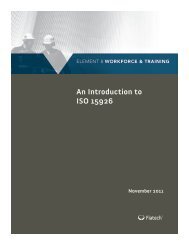Advancing Interoperability for the Capital Projects ... - iRINGToday
Advancing Interoperability for the Capital Projects ... - iRINGToday
Advancing Interoperability for the Capital Projects ... - iRINGToday
Create successful ePaper yourself
Turn your PDF publications into a flip-book with our unique Google optimized e-Paper software.
<strong>the</strong> business case <strong>for</strong> moving to new improved in<strong>for</strong>mation delivery processes, and believe <strong>the</strong> vision <strong>for</strong> <br />
<strong>the</strong> industry can be achieved to deliver business value. <br />
Development of In<strong>for</strong>mation Delivery Processes Pave <strong>the</strong> Way<br />
The building and process plant industries have defined <strong>the</strong>ir vision presented in Fiatech’s <strong>Capital</strong> <br />
<strong>Projects</strong> Technology Roadmap. Considerable progress has been achieved toward <strong>the</strong> Roadmap vision <br />
and actions plans have been developed and endorsed <strong>for</strong> continued advancement. Developing and <br />
delivering <strong>the</strong> IE standards that serve as a base <strong>for</strong> achieving <strong>the</strong> interoperability visions of <strong>the</strong> Roadmap <br />
are still lacking. <br />
Although organizations typically have unique in<strong>for</strong>mation requirements <strong>for</strong> <strong>the</strong> same activity, <br />
significant commonalities can be found in <strong>the</strong> purpose of in<strong>for</strong>mation delivery processes, document <br />
types, data sets, and guidance on <strong>the</strong> content. The use of in<strong>for</strong>mation delivery processes will assist <strong>the</strong> <br />
definition, capture, and delivery of in<strong>for</strong>mation in consistent <strong>for</strong>mats to enable data exchange and <br />
sharing among parties in cost-‐effective, quality assured mechanisms, resulting in improved delivery and <br />
use of capital facilities (less cost, higher quality, and improved environmental profile). For example, AISC <br />
may recommend specific in<strong>for</strong>mation requirements when exchanging steel in<strong>for</strong>mation <strong>for</strong> fabrication. <br />
Development and use of in<strong>for</strong>mation delivery processes within <strong>the</strong> industry begins to address <strong>the</strong> <br />
“arrows” depicted on <strong>the</strong> Roadmap, or ra<strong>the</strong>r <strong>the</strong> industry need <strong>for</strong> standardized IEs of structured <br />
in<strong>for</strong>mation. <br />
The building industry is developing an In<strong>for</strong>mation Delivery Manual (IDM, ISO 29481) to specify <strong>the</strong> <br />
types of in<strong>for</strong>mation required during facility construction or operation and to identify in<strong>for</strong>mation <br />
needed in activities such as cost estimating, volume of materials, and job scheduling. The components of <br />
<strong>the</strong> IDM that define <strong>the</strong> process map include business rules, functional parts, exchange requirements, <br />
and verification tests as illustrated in Figure 1. <br />
As depicted in <strong>the</strong> Roadmap, <strong>the</strong> ability to monitor and optimally maintain a facility’s assets during <br />
its life cycle is critical to an enterprise’s success. Thus, interoperability and <strong>the</strong> use of project in<strong>for</strong>mation <br />
through that life cycle, toge<strong>the</strong>r with an integrated and automated supply chain <strong>for</strong> design and <br />
construction, are two critical strategic areas within <strong>the</strong> capital projects industry. The use and <br />
management of engineering and construction in<strong>for</strong>mation <strong>for</strong> an integrated procurement supply chain <br />
and materials management, <strong>for</strong> fabrication, <strong>for</strong> commissioning, and <strong>for</strong> asset life cycles is limited by <strong>the</strong> <br />
inability to effectively manage, share, re-‐use, and re-‐purpose in<strong>for</strong>mation.<br />
<strong>Interoperability</strong> Vision Paper <strong>for</strong> Broad Industry Comment <br />
Page 4 of 13 <br />
Copyright © 2012 Fiatech.



